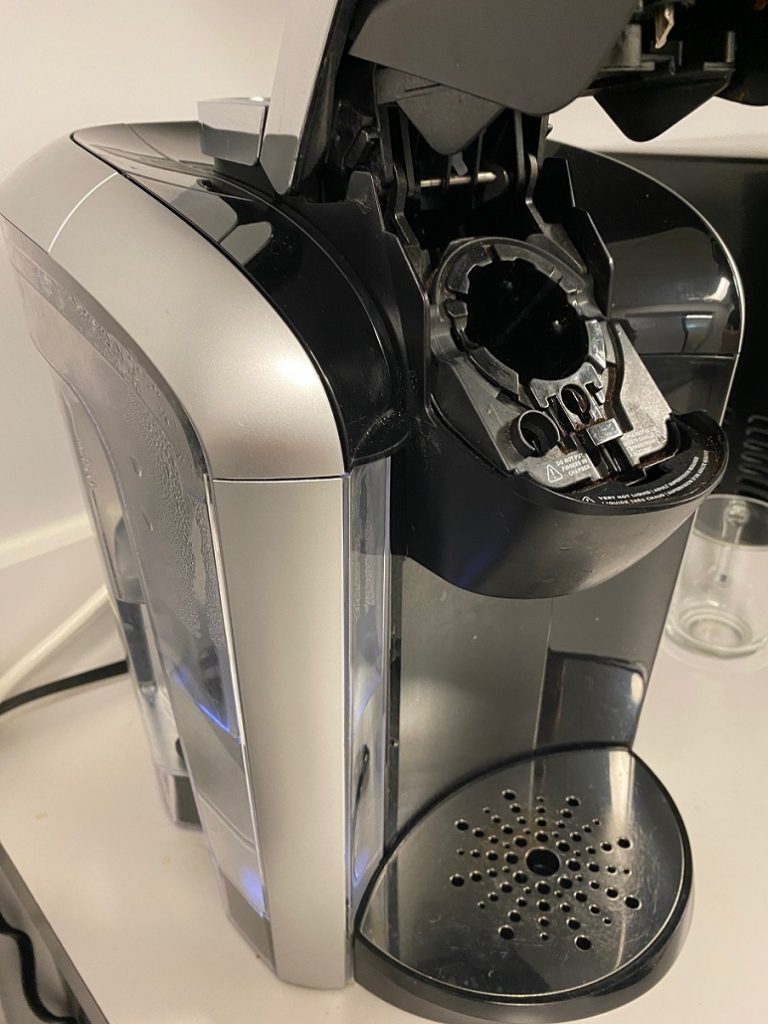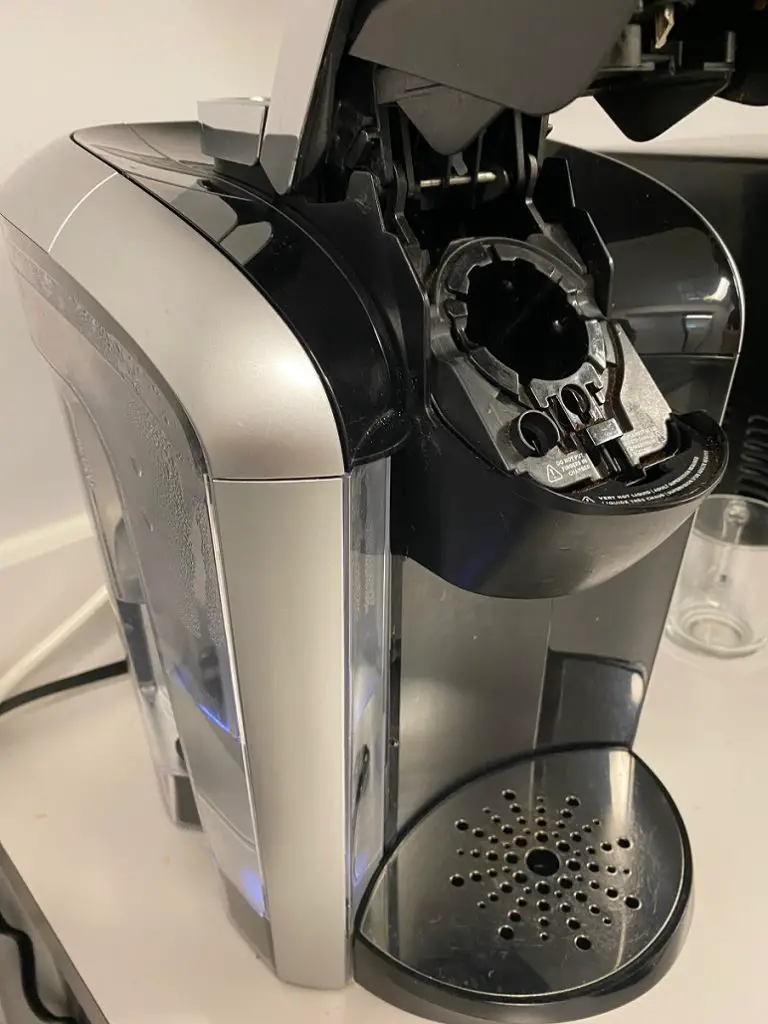Have you ever noticed mold growing in your Keurig water reservoir? It’s not only gross but can also be harmful to your health. Mold is a type of fungus that thrives in moist environments and can cause respiratory issues, allergies, and other health problems. Don’t worry; we’ve got you covered! In this article, we will walk you through the steps on how to clean mold from your Keurig water reservoir, so you can enjoy your coffee without any worries.
To clean mold from your Keurig water reservoir, first, unplug the machine and remove the reservoir. Then, empty any remaining water and rinse it with warm, soapy water. Use a soft-bristled brush to scrub away any visible mold. For tougher cases, mix a solution of equal parts water and white vinegar and let it sit in the reservoir for 30 minutes before scrubbing. Rinse the reservoir thoroughly with clean water before reattaching it to the machine. Repeat this process every three to six months to prevent mold growth.

How to Clean Mold from Keurig Water Reservoir?
If you own a Keurig coffee maker, you know how important it is to keep it clean to ensure the best-tasting coffee. One of the most important parts of your Keurig that needs regular cleaning is the water reservoir. If not properly maintained, mold can grow inside the reservoir, which can be harmful to your health. In this article, we will guide you on how to clean mold from Keurig water reservoir and keep your coffee maker in tip-top shape.
Why is Cleaning the Water Reservoir Important?
The water reservoir in your Keurig coffee maker is the most important part of the machine. This is where the water is stored before it is heated and used to brew coffee. Over time, mold and bacteria can grow in the reservoir, which can lead to health problems if not cleaned regularly. Not only that, but mold can also affect the taste of your coffee, making it bitter or sour.
Cleaning the water reservoir is essential to ensure the longevity of your Keurig coffee maker. Neglecting to clean the reservoir can cause damage to the machine and prevent it from working correctly. Cleaning your coffee maker regularly can also improve the quality of your coffee and prevent any unwanted flavors from developing.
Materials Needed to Clean the Water Reservoir
Before we get started on cleaning the water reservoir, let’s take a look at the materials you’ll need:
- White vinegar
- Warm water
- Clean cloth or sponge
- Small brush or toothbrush
Steps to Clean the Water Reservoir
Now that you have all the materials needed, let’s get started on cleaning the water reservoir:
Step 1: Unplug the Keurig coffee maker from the wall outlet and remove the water reservoir from the machine.
Step 2: Empty the water from the reservoir and rinse it with warm water.
Step 3: Mix equal parts of white vinegar and warm water. Pour the solution into the reservoir until it is halfway full.
Step 4: Place the reservoir back into the Keurig coffee maker and turn on the machine. Run a brew cycle without a K-Cup, allowing the vinegar solution to run through the machine.
Step 5: Once the brew cycle has finished, empty the reservoir and rinse it thoroughly with warm water.
Step 6: Use a small brush or toothbrush to clean any remaining mold or residue from the reservoir.
Step 7: Wipe down the exterior of the reservoir and the Keurig coffee maker with a clean cloth or sponge.
Step 8: Refill the reservoir with water and run a few brew cycles to ensure that all the vinegar solution has been flushed out of the machine.
Benefits of Cleaning Your Keurig Water Reservoir
Regularly cleaning your Keurig water reservoir has several benefits. Firstly, it ensures that your coffee maker is functioning correctly and prevents any damage to the machine. Secondly, it improves the quality of your coffee by removing any unwanted flavors caused by mold or bacteria. Lastly, it prevents any health problems caused by consuming mold or bacteria.
Conclusion
Cleaning the water reservoir of your Keurig coffee maker regularly is essential to ensure the longevity of the machine and the quality of your coffee. By following the steps outlined in this article, you can clean and maintain your coffee maker easily and efficiently. Remember to clean the reservoir every three to six months to keep your machine in tip-top shape.
Frequently Asked Questions
Keurig coffee makers are popular for their convenience, but mold can grow in the water reservoir if not cleaned regularly. Here are some frequently asked questions about how to clean mold from Keurig water reservoir.
Q: How do I know if there is mold in my Keurig water reservoir?
If you notice a strange odor or discoloration in your coffee, there may be mold in your Keurig water reservoir. You can also look inside the reservoir for visible mold growth. It’s important to clean your Keurig regularly to prevent mold growth and ensure the best-tasting coffee.
Once you’ve determined that there is mold, it’s time to clean your Keurig water reservoir. You can use vinegar or a Keurig descaling solution to effectively remove mold and mineral buildup.
Q: How often should I clean my Keurig water reservoir?
You should clean your Keurig water reservoir every three to six months, depending on how often you use it. If you use your Keurig every day, you may need to clean it more frequently. Regular cleaning will prevent mold growth and ensure that your coffee tastes its best.
To clean your Keurig water reservoir, you can use vinegar or a Keurig descaling solution. Follow the instructions on the descaling solution or use a mixture of equal parts water and white vinegar. Run the solution through your Keurig and then rinse it thoroughly with water.
Q: Can I use bleach to clean my Keurig water reservoir?
No, you should not use bleach to clean your Keurig water reservoir. Bleach can be dangerous if ingested and can also damage your Keurig’s internal components. Instead, use vinegar or a Keurig descaling solution to effectively remove mold and mineral buildup.
To clean your Keurig with vinegar, mix equal parts water and white vinegar and run the solution through your Keurig. Then, rinse the reservoir thoroughly with water to remove any remaining vinegar.
Q: How do I prevent mold from growing in my Keurig water reservoir?
To prevent mold from growing in your Keurig water reservoir, it’s important to clean it regularly. You should also empty the reservoir and leave it open to air dry between uses. This will prevent moisture from accumulating and creating an environment for mold to grow.
If you notice a strange odor or discoloration in your coffee, it may be a sign that there is mold in your Keurig water reservoir. In this case, it’s important to clean your Keurig as soon as possible to prevent further mold growth.
Q: Can I put my Keurig water reservoir in the dishwasher?
No, you should not put your Keurig water reservoir in the dishwasher. The high heat and harsh detergents can damage your Keurig’s internal components. Instead, you should clean your Keurig by hand using vinegar or a Keurig descaling solution.
To clean your Keurig with vinegar, mix equal parts water and white vinegar and run the solution through your Keurig. Then, rinse the reservoir thoroughly with water to remove any remaining vinegar.
The One Thing You Need to Clean Your Keurig | How to Kill Mold and Bacteria In Coffee Makers
In conclusion, cleaning mold from a Keurig water reservoir is not as difficult as it may seem. With the right tools and a little bit of patience, you can easily rid your machine of any unwanted mold or bacteria.
It’s important to note that prevention is key. Regularly cleaning your Keurig machine and water reservoir can help prevent mold growth in the first place.
Lastly, don’t forget to sanitize your machine after cleaning to ensure that all germs and bacteria are eliminated. By following these simple steps, you can enjoy a fresh and clean cup of coffee every time.

